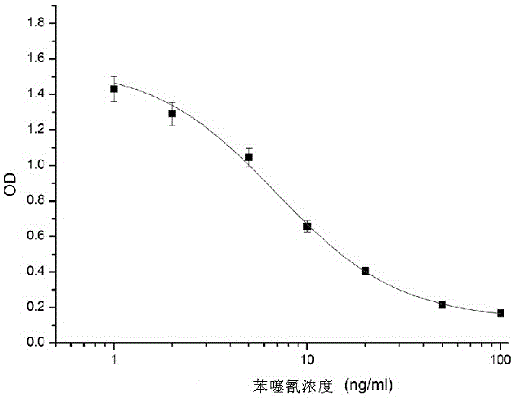TCMTB monoclonal antibody hybridoma cell strain and application thereof
A hybridoma cell line and antibody cloning technology, which is applied to biochemical equipment and methods, instruments, microorganisms, etc., can solve the problems of high cost, cumbersome operation, and time-consuming, and achieve good detection sensitivity and specificity
- Summary
- Abstract
- Description
- Claims
- Application Information
AI Technical Summary
Problems solved by technology
Method used
Image
Examples
Embodiment 1
[0036] The preparation of embodiment 1 hybridoma cell line 1B2
[0037] (1) Synthesis of complete antigen
[0038] Weigh 28.6 mg of TCMTB analogue 2-benzothiazolethioacetic acid (BTAC), 38.3 mg of EDC (carbodiimide), 23.0 mg of NHS (N-hydroxysuccinimide), and dissolve them in 1 mL of anhydrous DMF (called Solution A), stirred at room temperature for 8 h. Weigh 112 mg of BSA (bovine serum albumin) and dissolve it in 20 mL of 0.01 mol / LPBS with pH 7.4 (referred to as solution B). Add solution A to solution B drop by drop at room temperature, and react overnight at room temperature to obtain a conjugate The BTAC-BSA mixture is the complete antigen of thiocyanate, and the complete antigen and uncoupled small molecule hapten are separated by dialysis, and identified by ultraviolet absorption scanning method;
[0039] (2) Animal immunity
[0040] Healthy BALB / c mice aged 6-8 weeks were selected for immunization. After mixing and emulsifying the complete antigen of thiothiocyanat...
Embodiment 2
[0045] The preparation of embodiment 2 thiophene monoclonal antibodies
[0046] Take 8-10 week-old BALB / c mice, and inject 1 mL of paraffin oil into each mouse; 7 days later, each mouse is injected with 1×10 6 Hybridoma cell line 1B2, ascitic fluid was collected from the seventh day, the ascites fluid was purified by octanoic acid-ammonium sulfate method, and the monoclonal antibody obtained was stored at -20°C.
[0047] Determination of the IC of Thiophanidine Monoclonal Antibody Using an Indirect Competitive ELISA 50 It is: 7μg / L, indicating that it has good sensitivity to thiocyanate and can be used for immunoassay detection of thiocyanogen.
Embodiment 3
[0048] The application of embodiment 3 thiophene monoclonal antibody
[0049] The monoclonal antibody prepared by the hybridoma cell line 1B2 through the in vivo ascites was applied to the rapid detection of thiocyanate, and the specific steps were as follows:
[0050] (1) Coating: Dilute the coated original TCMTB-OVA with 0.05M pH9.6 carbonate buffer starting from 2μg / mL, 100μL / well, and react at 37°C for 2h;
[0051] (2) Washing: Pour off the solution in the ELISA plate, spin dry, and wash 3 times with washing solution, 3 minutes each time;
[0052] (3) Blocking: After patting dry, add carbonate buffer containing 0.01% gelatin as blocking solution, 200 μL / well, react at 37°C for 2 hours; wash and dry for later use;
[0053] (4) Adding samples: Dilute the antiserum starting from 1:1000, and add it to the coated wells of each dilution, 100 μL / well, and react at 37°C for 1 hour; after fully washing, wash with PBS containing 0.01% gelatin Add 1:3000 diluted HRP-goat anti-mouse...
PUM
 Login to View More
Login to View More Abstract
Description
Claims
Application Information
 Login to View More
Login to View More - R&D
- Intellectual Property
- Life Sciences
- Materials
- Tech Scout
- Unparalleled Data Quality
- Higher Quality Content
- 60% Fewer Hallucinations
Browse by: Latest US Patents, China's latest patents, Technical Efficacy Thesaurus, Application Domain, Technology Topic, Popular Technical Reports.
© 2025 PatSnap. All rights reserved.Legal|Privacy policy|Modern Slavery Act Transparency Statement|Sitemap|About US| Contact US: help@patsnap.com


